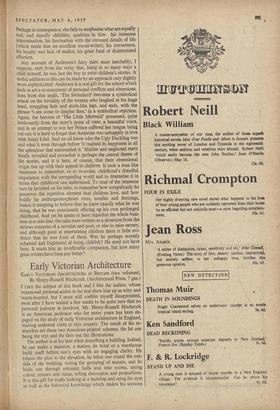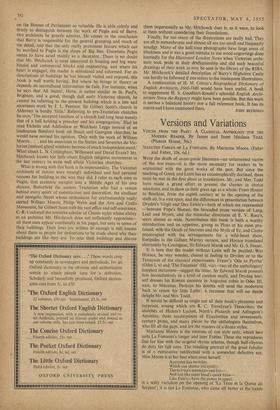. Early Victorian Architecture
EARLY VICTORIAN ARCHITECTURE IN BRITAIN (two Volumes).
I LIKE the subject of this book and I like the author, whose occasional personal asides in the text show him up as witty and 'warm-hearted, but I must still confess myself disappointed, even after I have waited a few weeks to be quite sure that no personal jealousy is involved. Mr. Henry-Russell Hitchcock is an American professor who for many years has been en- gaged on the study of early Victorian architecture in England, making endowed visits to this country. The result of his re- searches are these two American-printed volumes, the fat one being the text and the thin one the illustrations.
The author is at his best when describing a building. Indeed, he can make a mansion, a station, an hotel or a warehouse build itself before one's eyes with an engaging clarity. He relates the plan to the elevation, hp takes one round the out- side of the building, noting the grouping' of masses, and he leads one through entrance/ .halls and into rooms, seeing colour, texture and vistas, noting decoration and proportions. It is this gift for really looking at a building and using his eyes as well as his historical knowledge which makes his sections on the Houses of Parliament so valuable. He is able calmly and firmly to distinguish between the work of Pugin and of Barry, two architects he greatly admires. He comes to the conclusion that Barry is responsible for the general grouping and much of the detail, and that the only really prominent feature which can be ascribed to Pugin is the shape of Big Ben. Elsewhere Pugin seems to have acted mainly as a decorator. There is no doubt that Mr. Hitchcock is most interested in housing and big ware- houses and commercial blocks and engineering, and where his heart is engaged, the reader is stimulated and informed. For its descriptions of buildings he has himself visited and enjoyed, this book is well worth having. But where he brings in theory or depends on secondhand information he fails. For instance, when he says that All Sainti', Hove, is rather similar to St. Paul's, Brighton, and a good, though dull early Victorian church, he cannot be referring to the present building which is a late and enormous work by J. L. Pearson. Sir Gilbert Scott's church in Alderney is hardly 'little.' Referring to pre-Tractarian churches he says, 'The accepted function of a church had long been merely that of a hall holding a preacher and his congregation.' Had he read Etchells and Addlcshaw or Wickham Legge instead of an inadequate Batsford book on Stuart and Georgian churches, he would have revised his opinion. 'Only with the work of William Morris . . . and his associates in the Sixties and Seventies do Vic- torian [stained-glass] windows become of much independent merit.' What about L. N. Cottingham, Willcment and David Evans? Mr. Hitchcock knows too little about English religious movements in the last century to write well about Victorian churches.
What is wrong with this book is its impersonality. The Victorian architects of stature were strongly individual and had personal reasons for building in the way they did. I refer to such men as Pugin, that eccentric escapist into a Middle Ages of his own dreams, Butterfield the austere Tractarian who had a reason behind every quirk of construction and decoration, the ebullient and energetic Street whose enthusiasm for craftsmanship really started William Morris, Philip Webb and the Arts and Crafts Movement, Sir Gilbert Scott with his vast office and self-assurance, C. R. Cockerell the sensitive scholar of Classic styles whose ability as an architect Mr. Hitchcock does not sufficiently appreciate— all these men appear continually in his pages, but only in terms of their buildings. Their lives are written or enough is still known about them as people for deductions to be made about why their buildings are like they arc. To take their buildings and discuss them impersonally as Mr. Hitchcock does is, as it were, to look at them without considering their foundations.
Finally, far too many of the illustrations are really bad. They are all in monochrome and almost all are too small and frequently smudgy. Many of the half-tone photographs have large areas of blackness and it was a great mistake to use wood engravings done hurriedly for the Illustrated London News when Victorian archi- tects took pride in their draftsmanship and did such beautiful drawings of their work as may be seen in the library of the RIBA. Mr. Hitchcock's detailed description of Barry's Highclere Castle can hardly be followed if one refers to the inadequate illustrations.
A continuation of H. M. Calvin's Biographical Dictionary of English Architects, 1660-1840 would have been useful. A book to supplement H. S. Goodhart-Rendel's splendid English Archi- tecture Since the Regency might have been possible. But this work is neither a balanced history nor a full reference book. It has its
merits and I have mentioned them. JOHN BETJEMAN











































 Previous page
Previous page